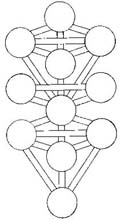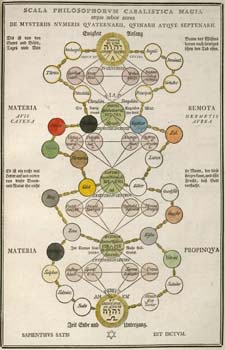Unpacking and publishing the Phaistos Disk since 1993
HOME | PREVIOUS | NEXT | SITEMAP
"Thou brakest the heads of leviathan in pieces, and gavest him to be meat to
the people inhabiting the wilderness." (Psalm 74)
- The great Serpent of Evil, with each of its heads having the name and crown of one of the Edomite kings. The Gnostic second Adam broke the heads of Leviathan in pieces. There is an account of Leviathan in the Ophite Diagram. Ouroboros (right) of alchemical writings, the serpent with his tail in his mouth, is erroneously called Leviathan.
- Horos-Stauros. The horizontal bar of the cross is Horos (Limit), the vertical bar is Stauros (Cross). Crosses are the symbol of Horos-Stauros, the absolute and impassable frontier of separation between the upper realms of the timeless world, and the temporal realms of the lower, visible universe. The location of the horizontal bar of the cross indicates the location of the Limit. The Greek Tau cross, with the horizontal bar resting atop the vertical bar, shows the highest Limit. The equal arms cross, which shows the horizontal bar exactly in the middle of the length of the vertical bar, indicates a lower Limit. The Christian cross and the Coptic cross, with the horizontal bars higher up, show a raised Limit, meaning that by gnosis and wisdom, the visible universe has raised itself closer to the higher realms where the supreme divinity resides. When humanity fell from Eden, the Limit lowered. The Egyptian Ankh is a Tau cross with a raised Limit that touches on the Pleroma, the sphere above the horizontal bar of that cross.
The part of the Universe known as the Intermediate Zone is the impassable frontier of the Limit-Cross wherein is the "Portal of Life.'' Below that is defined the limit of the abyss.
The Romans crucified their "criminals" on a cross with a high horizontal bar. When Jesus allowed himself to be nailed to the cross, or allowed the world to think he had been nailed to the cross, he was using the cross to make the statement that he had raised the Limit by lifting humanity closer to the divine realms (his "saved" us). Jesus would have known that Horos-Stauros is symbolized by a cross, the foremost symbol of religious groups then as now. Perhaps that is why the Romans chose that method of execution besides that its shape so perfectly suited their method of their favorite form of torture. Also, the irony of crucifying citizens on their own religious symbol may have appealed to their aberrated sense of humor. Jesus, by his sacrificial action, made Horos-Stauros the central symbol of Christianity. From ancient Persia comes this idea of the "Savior Saved." By saving others through sacrifice and involution, the Savior saves himself.
Plato wrote that the power which comes next to the highest God has been marked with a cross upon the universe. The Gnostics admired Plato and incorporated much of his thinking into their religious Philosophy. The cross symbol may have been adopted from him. In Gnostic manuscripts Jesus describes the true cross, the great Cross of Light, as being in heaven. The Gnostics envisioned this astral cross as traced upon the celestial dome of the skies.
- A Kabalist of the 16th century CE, whose writings express Gnostic ideas and who learned of the Kabala while in Egypt. Luria, in his cosmology, assumes the real existence of evil in a kingdom of its own. He tells of the fall of the portions of the light of the Pleroma down into the lowest depths. He writes of the "tsintsin," the withdrawal of God from His creation, vacating a portion of himself so creation can take place, and leaving a "reshimu," a residue of his divine light from which creation emerged. This parallels Basilides' teaching of the residue from which the Holy Spirit emerges. In the Books of Jeou, which Jesus of Gnosticism says must be mastered before salvation can occur, all primordial spaces came into being because of this little idea that God had left behind when He withdrew into Himself. I explore this idea in my book "The Shadow Breakers."
Themes such as these found in the medieval writings of the Jewish mystics are either a holdover from Gnosticism or a re-emergence of Gnostic thought. Expressing similar views were the medieval Kabalists, Moses de Leon and Joseph Gikatila. These Kabalistss (Cabalists) came up with a system of correspondences for the structure and creation of the universe that was later expanded by Jewish mystics into an elaborate system. Other mystical societies adopted their system diagram, the Kabala Tree of Life, (below left) and used it for their own purposes, in some instances, Magica, to forward their own versions of universal realities. I borrowed it myself and extended it to create my own version (below middle) involving universal field fabric and Interstellar Flight Portals.
It really does lend itself to this type of "borrowing" and continued construction of the ideas involved. I found it to be universal, renaming it the "World Soul," the concept borrowed from Plato, and discovered it all over the place in art throughout geography and history and so wrote another book about it entitled Forms and Archetypes of the World Soul. What started out as a very simple Kabala Tree design (left) became very elaboral (below right).


